
Concept explainers
(a)
Interpretation: The systematic name and common name of the given organic compound is to be interpreted.

Concept Introduction: Organic compounds are chemical compounds that are mainly composed of carbon and hydrogen atoms. The naming of organic compounds is followed the IUPAC rules. The longest chain of carbon atoms is considered the parent chain. The substituents must be given with the least locant number. The locant number must be written as the prefix in the IUPAC name.
(a)
Answer to Problem 47PP

The systematic name of the given compound must be 2-chloropropane and the common name is isopropyl chloride.
Explanation of Solution

In the given organic compound, the parent longest chain contains 3 carbon atoms so the root word must be propane with one substituent; chloro at C2 position. Thus, the systematic name of the given compound must be 2-chloropropane and the common name is isopropyl chloride.
(b)
Interpretation: The systematic name and common name of the given organic compound is to be interpreted.

Concept Introduction: Organic compounds are chemical compounds that are mainly composed of carbon and hydrogen atoms. The naming of organic compounds is followed the IUPAC rules. The longest chain of carbon atoms is considered the parent chain. The substituents must be given with the least locant number. The locant number must be written as the prefix in the IUPAC name.
(b)
Answer to Problem 47PP
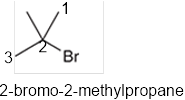
The systematic name of the given compound must be 2-bromo-2-methylpropane and the common name is tert-butyl bromide.
Explanation of Solution
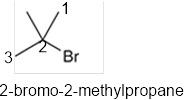
In the given organic compound, the parent longest chain contains 3 carbon atoms so the root word must be propane with two substituents: chloro and methyl at 2 positions. Thus, the systematic name of the given compound must be 2-bromo-2-methylpropane and the common name is tert-butyl bromide.
(c)
Interpretation: The systematic name and common name of the given organic compound is to be interpreted.

Concept Introduction: Organic compounds are chemical compounds that are mainly composed of carbon and hydrogen atoms. The naming of organic compounds is followed the IUPAC rules. The longest chain of carbon atoms is considered the parent chain. The substituents must be given with the least locant number. The locant number must be written as the prefix in the IUPAC name.
(c)
Answer to Problem 47PP

The systematic name of the given compound must be 1-iodopropane and the common name is propyl iodide.
Explanation of Solution

In the given organic compound the parent longest chain contains 3 carbon atoms so the root word must be propane with one substituent; iodo at 1 position. Thus, the systematic name of the given compound must be 1-iodopropane and the common name is propyl iodide.
(d)
Interpretation: The systematic name and common name of the given organic compound is to be interpreted.

Concept Introduction: Organic compounds are chemical compounds that are mainly composed of carbon and hydrogen atoms. The naming of organic compounds is followed the IUPAC rules. The longest chain of carbon atoms is considered the parent chain. The substituents must be given with the least locant number. The locant number must be written as the prefix in the IUPAC name.
(d)
Answer to Problem 47PP
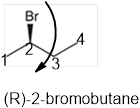
The systematic name of the given compound must be (R)-2-bromobutane and the common name is (R)- sec-butyl bromide.
Explanation of Solution
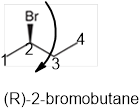
In the given organic compound the parent longest chain contains 4 carbon atoms so the root word must be butane with one substituent; bromo at C2 position. Thus, the systematic name of the given compound must be (R)-2-bromobutane and the common name is (R)- sec-butyl bromide. The prefix (R) indicates the clockwise rotation of the groups bonded at the chiral C atom when arranged from 1 to 4 in the increasing order of their
(e)
Interpretation: The systematic name and common name of the given organic compound is to be interpreted.

Concept Introduction: Organic compounds are chemical compounds that are mainly composed of carbon and hydrogen atoms. The naming of organic compounds is followed the IUPAC rules. The longest chain of carbon atoms is considered the parent chain. The substituents must be given with the least locant number. The locant number must be written as the prefix in the IUPAC name.
(e)
Answer to Problem 47PP
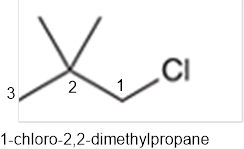
The systematic name of the given compound must be 1-chloro-2,2- dimethylpropane and common name is neopentyl chloride.
Explanation of Solution
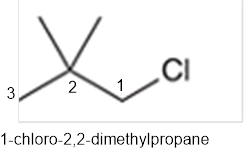
In the given organic compound, the parent longest chain contains 3 carbon atoms so the root word must be propane with three substituents as methyl and chloro at C1 and C2 position. Thus, the systematic name of the given compound must be 1-chloro-2,2- dimethylpropane and the common name is neopentyl chloride.
(f)
Interpretation: The systematic name and common name of the given organic compound is to be interpreted.

Concept Introduction: Organic compounds are chemical compounds that are mainly composed of carbon and hydrogen atoms. The naming of organic compounds is followed the IUPAC rules. The longest chain of carbon atoms is considered the parent chain. The substituents must be given with the least locant number. The locant number must be written as the prefix in the IUPAC name.
(f)
Answer to Problem 47PP

The systematic name of the given compound must be 4-bromo-3,3-dimethyl-4-propylhaptane.
Explanation of Solution
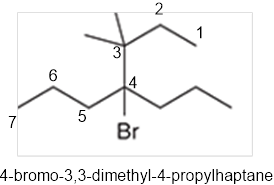
In the given organic compound the parent longest chain contains 7 carbon atoms so the root word must be haptane with four substituents as propyl, methyl and bromo. Thus, the systematic name of the given compound must be 4-bromo-3,3-dimethyl-4-propylhaptane.
Want to see more full solutions like this?
Chapter 7 Solutions
ORGANIC CHEMISTRY-STUD.SOLNS.MAN+SG(LL)
- What is the final product when D-galactose reacts with hydroxylamine?arrow_forwardIndicate the formula of the product obtained by reacting methyl 5-chloro-5-oxopentanoate with 1 mole of 4-penten-1-ylmagnesium bromide.arrow_forwardIn the two chair conformations of glucose, the most stable is the one with all the OH groups in the equatorial position. Is this correct?arrow_forward
- please help me with my homeworkarrow_forwardhelparrow_forwardThe temperature on a sample of pure X held at 1.25 atm and -54. °C is increased until the sample boils. The temperature is then held constant and the pressure is decreased by 0.42 atm. On the phase diagram below draw a path that shows this set of changes. pressure (atm) 2 0 0 200 400 temperature (K) Xarrow_forward
- QUESTION: Answer Question 5: 'Calculating standard error of regression' STEP 1 by filling in all the empty green boxes *The values are all provided in the photo attached*arrow_forwardpressure (atm) 3 The pressure on a sample of pure X held at 47. °C and 0.88 atm is increased until the sample condenses. The pressure is then held constant and the temperature is decreased by 82. °C. On the phase diagram below draw a path that shows this set of changes. 0 0 200 temperature (K) 400 аarrow_forwarder your payment details | bar xb Home | bartleby x + aleksogi/x/isl.exe/1o u-lgNskr7j8P3jH-1Qs_pBanHhviTCeeBZbufuBYT0Hz7m7D3ZcW81NC1d8Kzb4srFik1OUFhKMUXzhGpw7k1 O States of Matter Sketching a described thermodynamic change on a phase diagram 0/5 The pressure on a sample of pure X held at 47. °C and 0.88 atm is increased until the sample condenses. The pressure is then held constant and the temperature is decreased by 82. °C. On the phase diagram below draw a path that shows this set of changes. pressure (atm) 1 3- 0- 0 200 Explanation Check temperature (K) 400 X Q Search L G 2025 McGraw Hill LLC. All Rights Reserved Terms of Use Privacy Cearrow_forward
 Chemistry & Chemical ReactivityChemistryISBN:9781337399074Author:John C. Kotz, Paul M. Treichel, John Townsend, David TreichelPublisher:Cengage Learning
Chemistry & Chemical ReactivityChemistryISBN:9781337399074Author:John C. Kotz, Paul M. Treichel, John Townsend, David TreichelPublisher:Cengage Learning Chemistry & Chemical ReactivityChemistryISBN:9781133949640Author:John C. Kotz, Paul M. Treichel, John Townsend, David TreichelPublisher:Cengage Learning
Chemistry & Chemical ReactivityChemistryISBN:9781133949640Author:John C. Kotz, Paul M. Treichel, John Townsend, David TreichelPublisher:Cengage Learning Principles of Modern ChemistryChemistryISBN:9781305079113Author:David W. Oxtoby, H. Pat Gillis, Laurie J. ButlerPublisher:Cengage Learning
Principles of Modern ChemistryChemistryISBN:9781305079113Author:David W. Oxtoby, H. Pat Gillis, Laurie J. ButlerPublisher:Cengage Learning Chemistry for Today: General, Organic, and Bioche...ChemistryISBN:9781305960060Author:Spencer L. Seager, Michael R. Slabaugh, Maren S. HansenPublisher:Cengage Learning
Chemistry for Today: General, Organic, and Bioche...ChemistryISBN:9781305960060Author:Spencer L. Seager, Michael R. Slabaugh, Maren S. HansenPublisher:Cengage Learning



